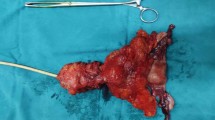Abstract
Cervical cancer constitutes a major health problem in Mexico and other developing countries. The purpose of our study was to assess the experience of a comprehensive national oncological reference center on pelvic exenteration for post-radiotherapy recurrent or persistent cervical cancer, describing the prognostic value of time to recurrence, procedure complications, and survival. Medical records from 42 patients with post-radiotherapy recurrent or persistent cervical cancer who underwent a pelvic exenteration with curative purposes from 1984 to 1989 were retrospectively reviewed. Histological diagnoses were squamous cell carcinoma (32 patients), adenosquamous carcinoma (9 patients), and adenocarcinoma (1 patient). Average follow up was of 56.3 mo after the procedure and global survival at 5 yr was 65.8%. Survival for patients with early recurrence was 56.9% vs 78% for patients with late recurrence (p=0.05). Complications were observed in 65.3% of the cases with a surgical mortality of 4.8%. Pelvic exenteration is a surgical procedure with high morbidity in spite of the recent medical advances. Pelvic exenteration should not be indicated with palliative purposes owing to the high rate of complications. Patients with tumor persistence or early recurrence have a worse prognosis. In well-selected cases, exenteration may provide a survival benefit.
Similar content being viewed by others
References
Dirección General de Epidemiología. Registro histopatológico de neoplasias en México. Morbilidad y mortalidad 2001. México: SSA, 2004.
Waggoner SE. Cervical cancer. Lancet 2003;361:2217–2225.
DiSaia PJ, Creasman WT. Clinical Gynecology Oncology, fifth Edition: 1997:51–106.
Kuzuya K. Chemoradiotherapy for uterine cancer: current status and perspectives. Int J Clin Oncol 2004;9:458–470.
Long HJ, 3rd. Current research directions for locally advanced cervix cancer. Curr Oncol Rep 2003;5:468–472.
Shibata K, et al. Usefulness of preoperative chemoradiation in locally advanced cervical carcinoma. Gynecol Obstet Invest 2004;57:93–99.
Vrdoljak E, Hamm W. Current state-of-the-art of concomitant chemoradiation in cervical carcinomas. Eur J Gynaecol Oncol 2003;24:475–479.
Hockel M. Surgical treatment of locally advanced and recurrent cervical carcinoma: overview on current standard and new developments. Onkologie 2003;26:452–455.
Shingleton HM, Soong SJ, Gelder MS, Hatch KD, Baker VV, Austin JM, Jr. Clinical and histopathologic factors predicting recurrence and survival after pelvic exenteration for cancer of the cervix. Obstet Gynecol 1989;73:1027–1034.
Brunschwig A, Pierce VK. Partial and complete pelvic exenteration; a progress report based upon the first 100 operations. Cancer 1950;3:972–974.
Graham JC, Pérez FJI. Evisceración pélvica por cáncer Avanzado. Rev Inst Nal Canc 1965;3:125–129.
Lopez MJ, Spratt JS. Exenterative pelvic surgery. J Surg Oncol 1999;72:102–114.
Magrina JF, Stanhope CR, Weaver AL. Pelvic exenterations: supralevator, infralevator, and with vulvectomy. Gynecol Oncol 1997;64:130–135.
Rutledge FN, Smith, JP, Wharton JT, O'Quinn AG. Pelvic exenteration: analysis of 296 patients. Am J Obstet Gynecol 1977;129:881–892.
Lawhead RA, Jr., Clark DG, Smith DH, Pierce VK, Lewis JL, Jr. Pelvic exenteration for recurrent or persistent gynecologic malignancies: a 10-year review of the Memorial Sloan-Kettering Cancer Center experience (1972–1981). Gynecol Oncol 1989;33:279–282.
Averette HE, Lichtinger M, Sevin BU, Girtanner RE. Pelvic exenteration: a 15-year experience in a general metropolitan hospital. Am J Obstet Gynecol 1984;150:179–184.
Anthopoulos AP, Manetta A, Larson JE, Podczaski ES, Bartholomew MJ, Mortel R. Pelvic exenteration: a morbidity and mortality analysis of a seven-year experience. Gynecol Oncol 1989;35:219–223.
Soper JT, et al. pelvic exenteration: factors associated with major surgical morbidity. Gynecol Oncol 1989;35:93–98.
Selman AE, Copeland LJ. Surgical management of recurrent cervical cancer. Yonsei Med J 2002;43(6):754–762.
Kecmanovic DM, et al. Management of advanced pelvic cancer by exenteration. Eur J Surg Oncol 2003;29:743–746.
Hatch KD, Shingleton HM, Soong SJ, Baker VV, Gelder MS. Anterior pelvic exenteration. Gynecol Oncol 1988;31:205–216.
Hockel M, Baussmann E, Mitze M, Knapstein PG. Are pelvic side-wall recurrences of cervical cancer biologically different from central relapses? Cancer 1994 15;74:648–655.
Goldberg JM, Piver MS, Hempling RE, Aiduk C, Blumenson L, Recio FO. Improvements in pelvic exenteration: factors responsible for reducing morbidity and mortality. Ann Surg Oncol 1998;5:399–406.
Rutledge S, Carey MS, Prichard H, Allen HH, Kocha W, Kirk ME. Conservative surgery for recurrent or persistent carcinoma of the cervix following irradiation: is exenteration always necessary? Gynecol Oncol 1994;52:353–359.
Tarraza HM, Ellerkmann RM. Pelvic radical surgery. Surg Oncol Clin N Am 1998;7(2):399–416.
Leitao MM, Jr, Chi DS. Recurrent cervical cancer. Curr Treat Options Oncol 2002;3:105–111.
Pandey D, Zaidi S, Mahajan V, Kannan R. Pelvic exenteration: A perspective from a regional cancer center in India. Indian J Cancer 2004;41:109–114.
Leitao MM, Jr, Chi DS. Recurrent cervical cancer. Curr Treat Options Oncol 2002;3:105–111.
Lambrou NC, Pearson JM, Averette HE. Pelvic exenteration of gynecologic malignancy: indications, and technical and reconstructive considerations. Surg Oncol Clin N Am 2005;14:289–300.
Salom EM, Penalver MA. Pelvic exenteration and reconstruction. Cancer J 2003;9:415–424.
Author information
Authors and Affiliations
Corresponding author
Rights and permissions
About this article
Cite this article
Terán-Porcayo, M.A., Zeichner-Gancz, I., Gomez del-Castillo, R.A.C. et al. Pelvic exenteration for recurrent or persistent cervical cancer. Med Oncol 23, 219–223 (2006). https://doi.org/10.1385/MO:23:2:219
Received:
Accepted:
Issue Date:
DOI: https://doi.org/10.1385/MO:23:2:219




